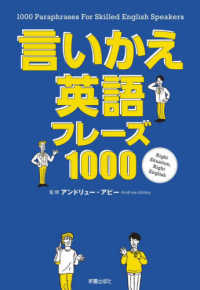- ホーム
- > 洋書
- > 英文書
- > Science / Mathematics
Full Description
The emergence over the past several years of space plasma simula tions as a distinct field of endeavor, rather than simply the somewhat startling offspring of plasma physics, computer simulations and space observations, has necessitated a concentrated effort at interdigitat ing its parent and component fields. After several years of working the benefits of a well-defined interactive community of those without working in the field, a group of those who had gained greatly from setting up joint research projects and other lines of communication, arranged to further these gains by setting up the First International School for Space Simulations, which was organized by Kyoto University and held in Kyoto, Japan in November 1982. Its unqualified success led to the organization of the second such School, this time by the University of California, Los Angeles, and held in Kapaa, Kauai, Hawaii. The Second International School for Space Simulations drew some 175 attendees from around the world; the distribution of attendees approached the targeted equal representation by established investi gators and graduate students/beginning investigators. This strong attendance by graduate students and beginning investigators was due to the generous support of a number of funding agencies from the United States and Japan as well as international scientific organizations.
Contents
1 — Simulations.- Fundamentals of Plasma Simulation.- Electromagnetic Particle Simulation Codes.- Elimination of Electromagnetic Radiation in Plasma Simulation: The Darwin or Magnetoinductive Approximation.- Particle Simulation Models for Low Frequency Microinstabilities in a Magnetic Field.- Hybrid Simulation Codes with Application to Shocks and Upstream Waves.- Implicit Plasma Simulation.- Time-Implicit Simulation of Particle-Fluid Systems.- Multidimensional Particle Codes: Their Capabilities and Limitations.- Wave-Particle Diagnostics for Plasma Simulation.- Particle Code Simulations with Injected Particles.- Optimizing Computational Efficiency and User Convenience in Plasma Simulation Codes.- Fluid Modeling of Magnetized Plasmas.- Global Simulations Using MHD Codes: A Few Points to Consider Before You Try One.- The Future of Space Plasma Simulation.- 2 — Observations.- Plasmas in the Earth's Magnetotail.- Wave Observations in Outer Planet Magnetospheres.- The Menagerie of Geospace Plasma Waves.- Observations of Low Energy Magnetospheric Plasma Outside the Plasmasphere.- Field-Aligned (Birkeland) Currents.- Large Electric Fields in the Magnetosphere.- Plasma Observations in the Auroral and Polar Cap Region.- Observations of Ion Cyclotron Waves Near Synchronous Orbit and on the Ground.- Dynamics of the Earth's Ring Current: Theory and Observation.- 3 — Theory.- Space Plasma Turbulent Dissipation: Reality or Myth?.- Kinetic Theory of Plasma Waves.- Coherent Nonlinear Effects on Electromagnetic Wave-Particle Interactions.- Whistler Mode Propagation in the Earth and Planetary Magnetospheres and Ray Tracing Techniques.- Coupling of Macroscopic and Small Scale Phenomena.- Global Energy Regulation in the Solar Wind-Magnetosphere-Ionosphere System.- Auroral ArcFormation: Kinetic and MHD Effects.- Consequences of Hydromagnetic Waves on Magnetospheric Particle Dynamics.- Spectral Computation of Tandem Mirror Equilibria with Finite Larmor Radius Effects.- ISSS2 Participants and Contributors.- ISSS2 Supporting Organizations.- Author Index.- Announcement.








